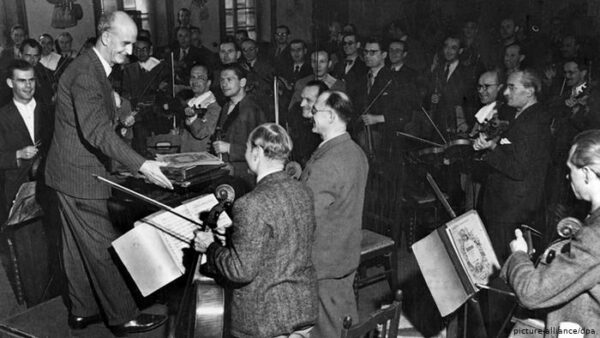Book Review: “Beethoven in the Bunker” — A Welcome, But Scattered, Point of Departure
By Jonathan Blumhofer
In place of coherent, in-depth analysis, the author has provided us with a series of short profiles on various individuals, some of them familiar, others less so. The tack presents problems that can’t be overcome.
Beethoven in the Bunker: Musicians Under the Nazi Regime by Fred Brouwers. Translated by Eileen J. Stevens. Other Press, 240 pp., $25.99.
 It’s hard to stay frustrated at Fred Brouwers’s Beethoven in the Bunker, even though the text hardly lives up to the back cover’s promise to offer a “compelling survey” of the relationship between classical music and National Socialism. Certainly there’s room for a good new book or two to be written on that topic: Michael Kater’s The Twisted Muse is, after all, more than 30 years old. Unfortunately, this effort isn’t the one.
It’s hard to stay frustrated at Fred Brouwers’s Beethoven in the Bunker, even though the text hardly lives up to the back cover’s promise to offer a “compelling survey” of the relationship between classical music and National Socialism. Certainly there’s room for a good new book or two to be written on that topic: Michael Kater’s The Twisted Muse is, after all, more than 30 years old. Unfortunately, this effort isn’t the one.
In place of coherent, in-depth analysis, Brouwers — whose background as a retired Flemish radio and television presenter gives him a certain familiarity with the artists under discussion — has provided a series of short profiles on various individuals, some of them familiar, others less so. While this is an understandable approach to such a big subject, the tack presents problems that the author doesn’t always overcome.
For one, Brouwers’s selection process is anybody’s guess. It’s no surprise to find Richard Strauss, Anton Webern, Paul Hindemith, and Franz Lehár included here. Or, for that matter, the fiercely anti-Fascist Arturo Toscanini and the Nazi sympathizer Willem Mengelberg.
It is odd, though, to have no chapter devoted to Wilhelm Furtwängler’s complicated relationship with the regime. Granted, he turns up in other peoples’ stories. But why focus on Herbert von Karajan — who, for all his postwar successes, was an up-and-comer during the years of the Reich — at Furtwängler’s expense? If anything, a side-by-side study of these two men might have provided a fascinating compare-and-contrast.
That other heavy hitters (like Arnold Schoenberg, Alban Berg, Kurt Weill, and Erich Wolfgang Korngold) are absent from the discussion is likewise strange. Granted, Berg died in 1935 and Schoenberg had left Germany two years before; even so, their innovations pervaded Nazi concepts of entartente Musik.
The Jewish artists Brouwers does discuss are even more of a hodge-podge. Violinist Bronislaw Huberman, cellist Anita Lasker (herself the subject of an engrossing recent documentary), and composer Hanns Eisler are present. And the inclusion of Paul Abraham, Josef Bor, and Rafael Schächter are welcome.
But what of Pavel Haas? Or Viktor Ullman? Or Alma Rosé? Or her father Arnold? Or Hans Krása? Admittedly, there are countless stories to tell, and, in any book, choices need to be made. Yet given how broadly Brouwers paints some of his elect and the relative brevity of the volume (its 240 pages are anything but exhaustive), surely there’s room for more – especially for musicians of greater significance than some of those already chosen.
Equally frustrating are Brouwers’s judgments. Does the fact that Strauss’s career (and life) ended in the transfixing song cycle Vier letzte Lieder really mean that, as the author puts it, “much” — meaning dedicating songs to Josef Goebbels, accepting high-profile Nazi commissions, and lending one’s name to a certain regime’s cause — “can be forgiven”?

Wilhelm Furtwängler conducts the Berlin Philharmonic in 1935 with Nazi prominence in attendance. Photo:Wiki Common
Or might the verdict pronounced on Elly Ney (a favorite pianist of Hitler’s and fervent postwar devotee to National Socialism, whose chapter comes after Strauss’s) apply equally to the composer? “Music,” Brouwers writes a few pages later, “does not always by definition improve a person’s moral fiber.” One might hope for as much, but the criteria for the author’s appraisals is never spelled out.
Taking the time to do that might have benefited the larger work. Likewise, including a chapter that wraps everything up — as well as connects (or at least mentions) some of the personalities neglected in these pages — would have been helpful. It certainly couldn’t have hurt: as things stand, there’s a certain haphazard, disjunct quality to both Brouwers’s organization of his materials and his conclusions.
That said, Beethoven in the Bunker is a book whose heart is in the right place. Brouwers’s enthusiasm for telling these stories — in Eileen J. Stevens’ serviceable translation, no less – is palpable. His zeal to include anecdotes (like the tragic tale of tenor Joseph Schmidt and the curious career of Paul Douliez) that one otherwise likely never would have encountered is admirable. Best of all, the appendix includes a playlist totaling more than 100 selections.
The last is a welcome point of departure for further investigation of this topic, one that, after nearly eight decades, remains as fascinating and harrowing as ever. It is also, fundamentally, the redeeming virtue of a book one hoped would add up to much more than the sum of its parts.
Jonathan Blumhofer is a composer and violist who has been active in the greater Boston area since 2004. His music has received numerous awards and been performed by various ensembles, including the American Composers Orchestra, Kiev Philharmonic, Camerata Chicago, Xanthos Ensemble, and Juventas New Music Group. Since receiving his doctorate from Boston University in 2010, Jon has taught at Clark University, Worcester Polytechnic Institute, and online for the University of Phoenix, in addition to writing music criticism for the Worcester Telegram & Gazette.
